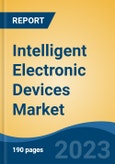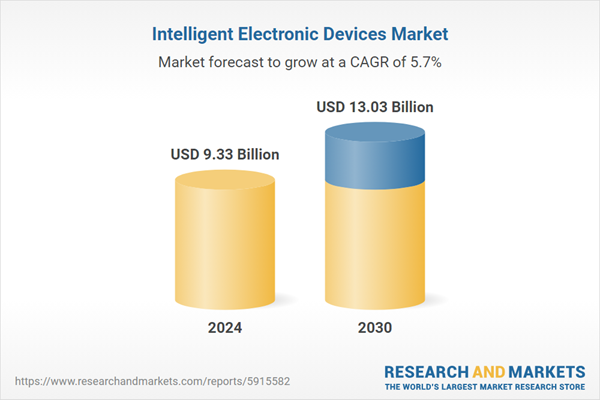Energy & Power is the fastest growing segment, North America is the largest regional market
Speak directly to the analyst to clarify any post sales queries you may have.
10% Free customizationThis report comes with 10% free customization, enabling you to add data that meets your specific business needs.
Key Market Drivers
The expansion of smart grid infrastructure stands as a pivotal driver for the Global Intelligent Electronic Devices market, transforming traditional power networks into resilient, efficient, and interactive systems. IEDs are fundamental to this evolution, enabling real-time monitoring, automated fault detection, and intelligent control of grid assets such as substations and feeder lines. Their capabilities facilitate enhanced grid stability and the seamless integration of distributed energy resources, including a growing influx of renewables. These devices are essential for managing complex bi-directional power flows and optimizing energy distribution across the network.According to the International Renewable Energy Agency (IRENA), in September 2024, 'Utilities Announce Joint Intent to Invest more than US$116bn Annually in Grids and Renewables', leading utility companies committed to investing over US$116 billion per year in power system grid infrastructure and clean power generation globally, with 48 percent of this specifically targeting transmission and distribution infrastructure. This substantial investment underscores the critical role of IEDs in supporting the modernization and digitalization efforts necessary for a future-ready grid.
Key Market Challenges
The high initial investment required for deploying Intelligent Electronic Devices (IEDs) significantly impedes the global market's expansion. The substantial capital expenditure associated with implementing IEDs, particularly in large-scale projects such as smart grid infrastructure development or extensive industrial automation systems, creates a considerable financial barrier. This challenge is especially pronounced for smaller utilities or enterprises that often operate with limited financial resources, thereby constraining their ability to upgrade existing infrastructure or invest in new IED-enabled systems.This elevated cost directly hampers the widespread adoption of advanced IED solutions. According to the Edison Electric Institute (EEI), U. S. investor-owned electric companies invested a record $178.2 billion in 2024 to enhance grid intelligence and security. Furthermore, these companies are projected to invest nearly $208 billion in 2025 for similar grid upgrades. The sheer magnitude of these required investments highlights the financial hurdle, causing many entities to defer or scale back crucial IED integration projects and slowing overall market growth.
Key Market Trends
Pervasive integration of Artificial Intelligence and Machine Learning into Intelligent Electronic Devices represents a pivotal evolution, enabling advanced analytical capabilities for predictive decision-making and self-optimization at the edge. These intelligent IEDs process extensive data to discern complex patterns and adapt operations in real-time, significantly enhancing efficiency and system reliability. Manufacturing and energy sectors, critical for IED adoption, were identified among the top five industry sectors most impacted by technology in 2024. According to "The Impact of Technology in 2024 and Beyond: an IEEE Global Study" in October 2023, 65% of technology leaders surveyed considered Artificial Intelligence the most important technology, highlighting its transformative role in enabling proactive maintenance and anomaly detection for critical infrastructure.Key Market Players Profiled:
- ABB Ltd
- Schneider Electric S.E.
- Siemens AG
- Honeywell International Inc.
- Eaton Corporation plc
- Rockwell Automation Inc.
- General Electric Company
- Cisco Systems Inc.
- NovaTech LLC
- SUBNET Solutions Inc.
Report Scope:
In this report, the Global Intelligent Electronic Devices Market has been segmented into the following categories:By Type:
- Digital Relay
- Voltage Regulator
- Protection Relay
- Circuit Breaker Controller
- Load Tap Changer Controller
- Recloser Controller
- Capacitor Bank Switch
By Application:
- Automation
- Condition Monitoring
- Traction Signalling & Control System
By Industry Vertical:
- Automotive
- Energy & Power
- Food & Beverages
- Pharmaceutical
By Region:
- North America
- Europe
- Asia-Pacific
- South America
- Middle East & Africa
Competitive Landscape
Company Profiles: Detailed analysis of the major companies present in the Global Intelligent Electronic Devices Market.Available Customizations:
With the given market data, the publisher offers customizations according to a company's specific needs. The following customization options are available for the report.Company Information
- Detailed analysis and profiling of additional market players (up to five).
This product will be delivered within 1-3 business days.
Table of Contents
Companies Mentioned
The companies profiled in this Intelligent Electronic Devices market report include:- ABB Ltd
- Schneider Electric S.E.
- Siemens AG
- Honeywell International Inc.
- Eaton Corporation plc
- Rockwell Automation Inc.
- General Electric Company
- Cisco Systems Inc.
- NovaTech LLC
- SUBNET Solutions Inc.
Table Information
| Report Attribute | Details |
|---|---|
| No. of Pages | 181 |
| Published | November 2025 |
| Forecast Period | 2024 - 2030 |
| Estimated Market Value ( USD | $ 9.33 Billion |
| Forecasted Market Value ( USD | $ 13.03 Billion |
| Compound Annual Growth Rate | 5.7% |
| Regions Covered | Global |
| No. of Companies Mentioned | 11 |









